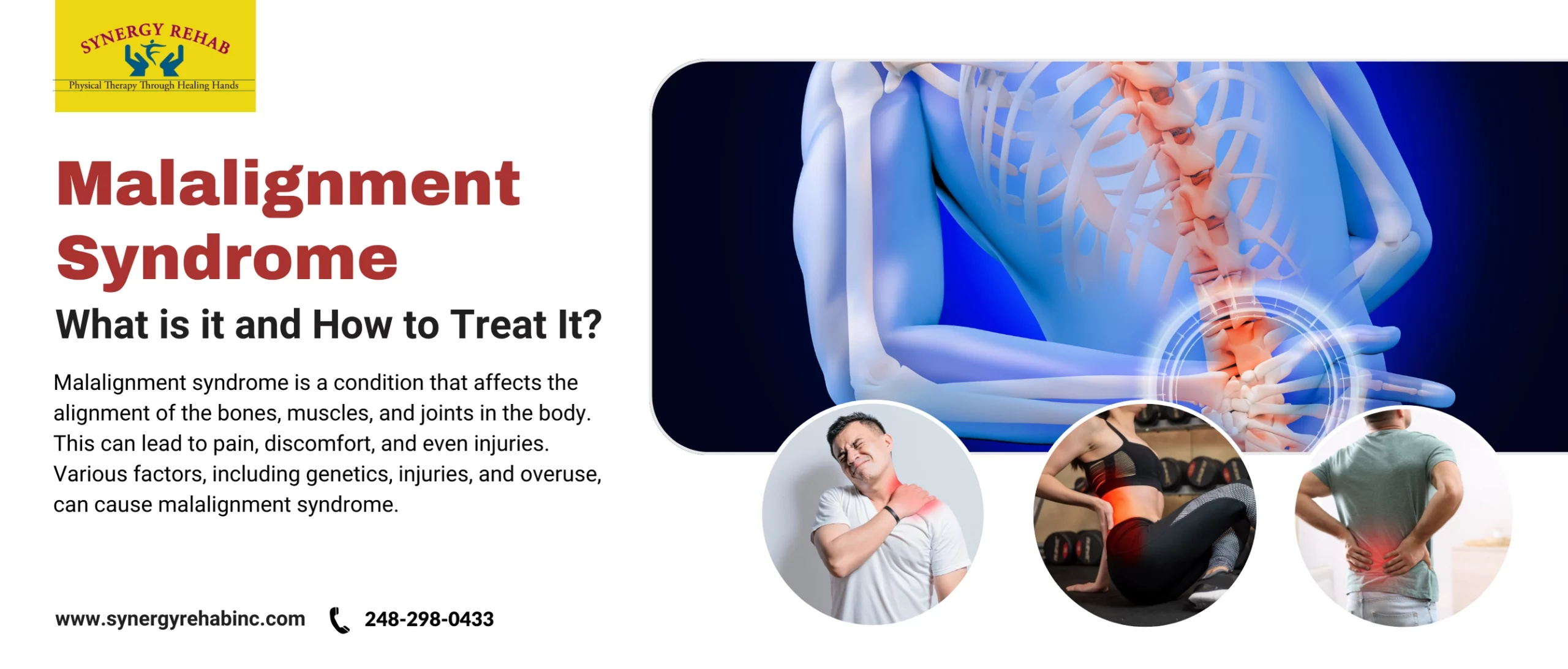
Malalignment syndrome is a condition that affects the alignment of the bones, muscles, and joints in the body. This can lead to pain, discomfort, and even injuries. Various factors, including genetics, injuries, and overuse, can cause malalignment syndrome.
It is important to note that pain-related Malalignment Syndrome can be localized or away from the injured site as a referred pain.
If you are suffering from constant pain and discomfort, it could be a sign of malalignment syndrome. Let us help you understand some common causes.
- One of the most common causes of malalignment syndrome is muscle imbalance. When the muscles in the body are not evenly balanced, it can put strain on the bones and joints. This can lead to pain, inflammation, and even injuries.
- Another common cause of malalignment syndrome is poor gait. Gait is the way you walk. When your gait is not aligned properly, it can put stress on your bones and joints. This can lead to pain, discomfort, and even injuries.
- Injuries caused by falls, auto accidents, or sports are some of the leading reasons of malalignment syndrome. If you have an injury that affects the bones, muscles, or joints, it can lead to malalignment syndrome.
The symptoms of malalignment syndrome can vary depending on the severity of the condition. Some common symptoms include:

- Pain in the bones, muscles, or joints
- Swelling in the bones, muscles, or joints
- Decreased range of motion
- Muscle weakness
- Fatigue
- Difficulty walking or running
If you are experiencing any of these symptoms, it is important to see a doctor or the best physical therapist in Southfield to get a diagnosis and treatment plan.
The treatment for malalignment syndrome depends on the severity of the condition and the underlying cause. However, you do not always have to rely on serious medications and surgical treatments. In most cases, non-invasive treatments such as physical therapy, stretching, and exercise prove effective in correcting the problem.
How can physical therapy help to treat malalignment syndrome?
Improving muscle strength: Weak muscles can contribute to malalignment syndrome by not being able to support the bones and joints properly. Physical therapy can help to strengthen these muscles, which can help to correct the alignment of the bones and joints.
Improving muscle flexibility: Tight muscles can also contribute to malalignment syndrome by pulling on the bones and joints in a way that causes them to become misaligned. Physical therapy can help to stretch these muscles, which can help to improve the range of motion of the joints and reduce pain.
Reducing pain and inflammation: Physical therapy can also help to reduce pain and inflammation associated with malalignment syndrome. This can be done through various techniques, such as massage, heat therapy, and ice therapy.
Synergy Rehab’s Unique Treatment Approach for Pain and Dysfunction:
1. Unique Manual Therapy:
One of the primary treatments involves using Unique Manual Therapy techniques, including Muscle Energy and Mulligan methods. These techniques are utilized to reposition the joints, effectively reducing stress on the joints and surrounding tissues and thereby alleviating pain and inflammation.
2. Stabilization and Strengthening Program:
After repositioning the joint through Unique Manual Therapy, a key aspect of the treatment is ensuring stability, achieved by implementing a specialized program focused on retraining specific muscles and improving posture.
3. Posture, Body Mechanics, and Home Program:
In addition to manual therapy and stabilization, attention is given to posture and body mechanics. Patients are given guidance and training to incorporate normal movement patterns into their daily lives. This comprehensive approach aims not only to relieve current pain and dysfunction but also to prevent their re-occurrence.
Stretching, which is an integral part of physical therapy, can help to treat malalignment syndrome by:
- Improving the range of motion of the affected joints and muscles can help relieve pain and improve function.
- Reducing muscle tightness: Tight muscles can contribute to malalignment syndrome by pulling on the bones and joints in a way that causes them to become misaligned. Stretching can help to relax these muscles and improve the alignment of the bones and joints.
- Increasing flexibility: Flexibility is important for overall health and well-being. It can also help to prevent injuries.
Manual exercises, often taught by the best physical therapists in Southfield, can help to treat malalignment syndrome by:
- Strengthening the muscles: Strong muscles can help to support the bones and joints and prevent them from becoming misaligned.
- Improving balance and coordination: Balance and coordination are important for preventing falls and other injuries. Exercise can help to improve these skills.
- Reducing stress: Stress can contribute to muscle tension and pain. Exercise can help to reduce stress and improve overall health.
It is important to note that physical therapy, stretching, and exercise for malalignment syndrome can be very effective in managing the symptoms and preventing further problems only if experienced and skilled physical therapists in Southfield provide the treatment. If you are experiencing malalignment syndrome, seeing a physical therapist to develop a personalized treatment plan is important.
Here are some specific exercises that prove to be helpful for people with malalignment syndrome:

- Hamstring stretches: Hamstring stretches can help improve the hamstrings’ flexibility, which can help relieve pain in the back and hips.
- Calf stretches: Calf stretches can help improve the calves’ flexibility, which can help relieve pain in the ankles and feet.
- Hip flexor stretches: Hip flexor stretches can help to improve the flexibility of the hip flexors, which can help to relieve pain in the groin and lower back.
- Core exercises: Core exercises can help strengthen the abdomen and back muscles, which can help improve posture and stability.
- Balance exercises: Balance exercises can help to improve balance and coordination, which can help to prevent falls and other injuries.
The specific exercises that are right for you will depend on the severity of your malalignment syndrome and your overall health. Expert physical therapists at Synergy Rehab can help you develop a personalized exercise program that is safe and effective for you. It is also important to perform these exercises under the expert guidance of such professionals.
If you are diagnosed with malalignment syndrome, following your physical therapist’s instructions is important. With proper treatment, most people with malalignment syndrome can get relief from their symptoms and improve their quality of life.
Here are some tips for preventing malalignment syndrome:
- Stay active and exercise regularly
- Stretch regularly
- Maintain a healthy weight
- Wear supportive shoes
- Avoid activities that put stress on your joints
- See a physical therapist if you have any pain or discomfort
If you are experiencing any of the symptoms of malalignment syndrome, it is important to see a physical therapist.

Looking for a physical therapist in Southfield? We are happy to help you.
At Synergy Rehab, we specialize in identifying the root cause of malalignment syndrome and treating it. We use various manual therapy techniques to provide long-lasting and effective relief. With our extensive experience in treating malalignment syndrome and other musculoskeletal conditions, we can help you develop a personalized treatment plan tailored to your specific needs that will help you get relief from your pain and improve your function.
We are committed to helping you get back to living your life pain-free.
Call us today to schedule a consultation and learn more about how we can help you.

